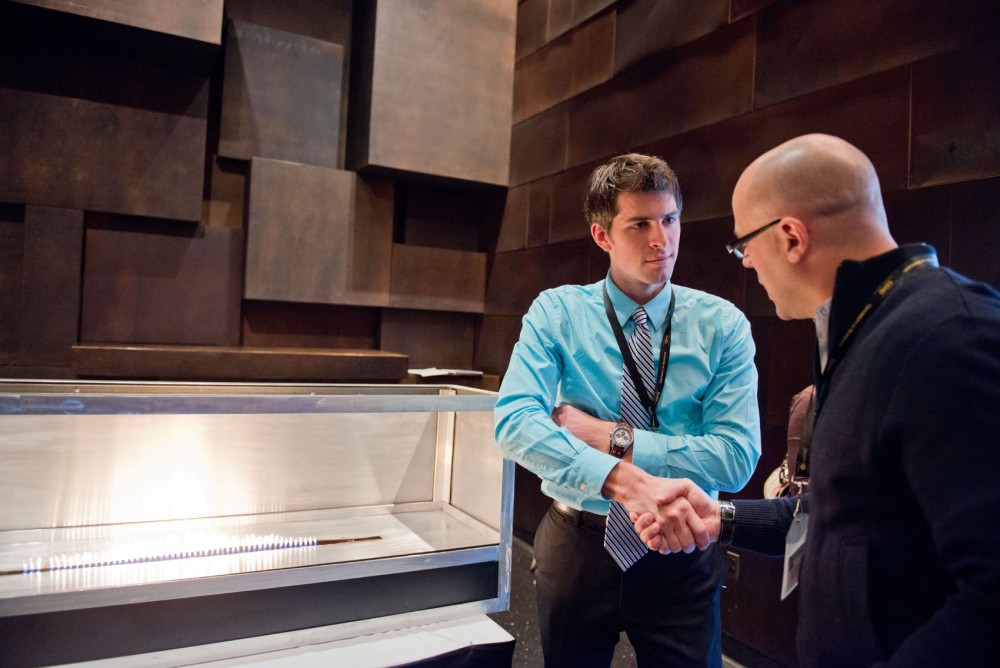The importance of technology in the future of education is clear. But to researchers at the University of Minnesota, it’s more than a necessity: it’s a business.
University President Eric Kaler emphasized this during his opening address at the EduTech Showcase and Forum held Monday at the McNamara Alumni Center.
The purpose of the showcase, sponsored by the College of Education and Human Development and nonprofit TiE Minnesota, was to define the “frontier of education, research and entrepreneurship.”
About 170 professors, teachers and businesspeople attended the event to get a glimpse of the latest education technologies, many of which were developed at the University.
“We are in the business of moving the University of Minnesota into an organization that is more business-friendly, more viable and more entrepreneurial,” Kaler said.
Zmach
While some students took a break this summer, four University physics students started a company.
Their product, FireWave, is a high-tech fireplace with flames that increase in size with the volume of music. Students presented it at the conference.
The founders of Zmach started working on their project through the Nikola Tesla Patent Producers student group. Last March, the group decided to develop a tangible product for the Minnesota Cup, an annual invention competition cohosted by the University. They placed third in the student division.
FireWave co-founder Hunter Dunbar said he especially enjoyed showing the product to Boy Scout troops and elementary classes.
Lois Josefson, executive director of TiE Minnesota, said she invited Zmach to the showcase because of these outreach efforts.
“I was proud of them for — on their own — going to tell their story to say, ‘You can take what you’re learning and do something with it,’” she said.
Zmach currently has a provisional patent for FireWave, and Dunbar said they are raising money to apply for an all-inclusive patent.
LT Media Lab
Developments from the University’s LT Media Lab were also showcased at the event.
Charles Miller, CEHD professor and LT Media Lab co-director, presented two technologies currently used in classrooms across the country.
Ave is an online platform that aims to teach foreign languages more effectively. To use the program, teachers create video assignments that spark video dialogue between student and teacher.
In the past six years, Ave has been used at more than 25 universities, and 30,000 students have completed 3.9 million video assignments, Miller said — about 130 tasks per student.
“If you can get students to do 130 of anything,” he said in his presentation, “you’re the best teacher in the world.”
LT Media Lab plans to take this technology to high schools with partner EMC Publishing.
The second technology Miller presented, Earthducation, is an interactive online platform where students can follow LT Media Lab members around the world as they ask, “How do education and sustainability intersect in your life?”
They have already gone to the North Pole, Africa and Europe. The group will embark on an expedition to South America on Oct. 20.
Education and technology
A main focus of the conference was emphasizing that students don’t learn the same but that technology can make up the difference by tailoring to the learning style of each student.
Kara Coffino, coordinator for the CEHD Research, Innovation and Outreach Center, said she thought the conference presented a good mix of perspectives on the convergence of education and technology.
“As someone who works with K12 theory and practical, professional development, it’s been very interesting,” she said.
Hanna Erpestad, dean of liberal arts and sciences at Lake Superior College, said she came to the conference to stay up to date on education technologies.
“It’s a blend of something new and reassuring to us that we may be on the right track,” she said.
Erpestad, who also oversees the e-learning program, said 30 percent of the classes LSC offers are online. She said she was also able to form a few potential partnerships with companies in attendance.
The goal of the showcase was to bring together innovations in education, technology, science and art, Josefson said.
“It’s important in society to an ever-increasing degree, in my opinion, that silos get crossed,” she said, “and technology is really driving the crossing of these silos.”


